Decision Making in Leadership: A Report on 21st Century Leadership
VerifiedAdded on 2022/08/12
|12
|2765
|24
Report
AI Summary
This report delves into the critical role of decision-making in 21st-century leadership, examining its profound impact on organizational success. The report begins with an introduction that sets the terms of reference and outlines the methodology, which employs a deductive research approach, relying on secondary data from peer-reviewed journals and articles, incorporating a quantitative analysis to derive transparent conclusions. The findings highlight the importance of identifying critical factors and potential solutions, emphasizing that decision-making affects the efficacy of a leader. The analysis section explores the benefits of effective decision-making, such as improved leadership abilities and cost-effectiveness. However, the report also acknowledges challenges, like indecisiveness and limited resources. The report concludes with recommendations for leaders to consider resource availability and organizational needs when making decisions.
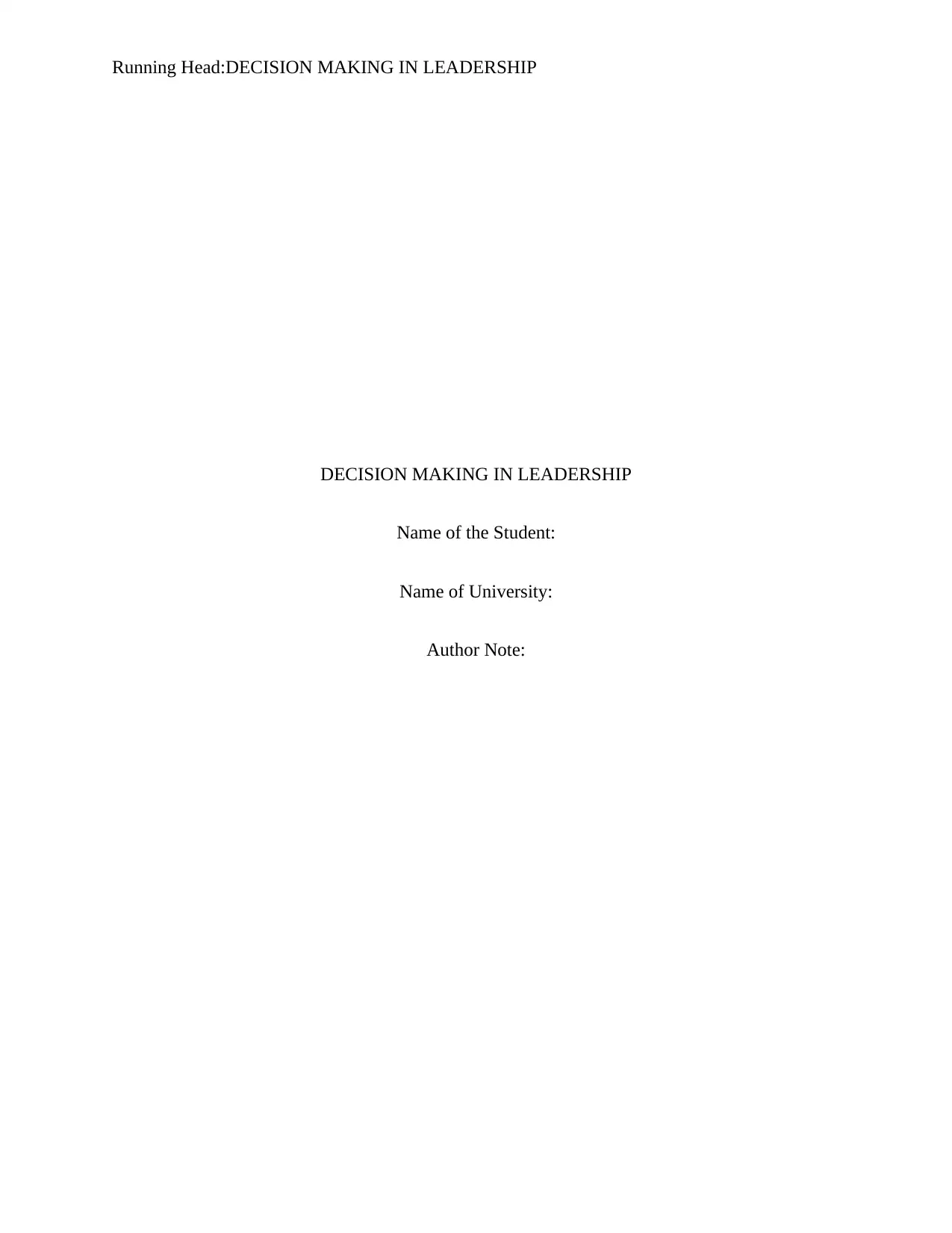
Running Head:DECISION MAKING IN LEADERSHIP
DECISION MAKING IN LEADERSHIP
Name of the Student:
Name of University:
Author Note:
DECISION MAKING IN LEADERSHIP
Name of the Student:
Name of University:
Author Note:
Paraphrase This Document
Need a fresh take? Get an instant paraphrase of this document with our AI Paraphraser
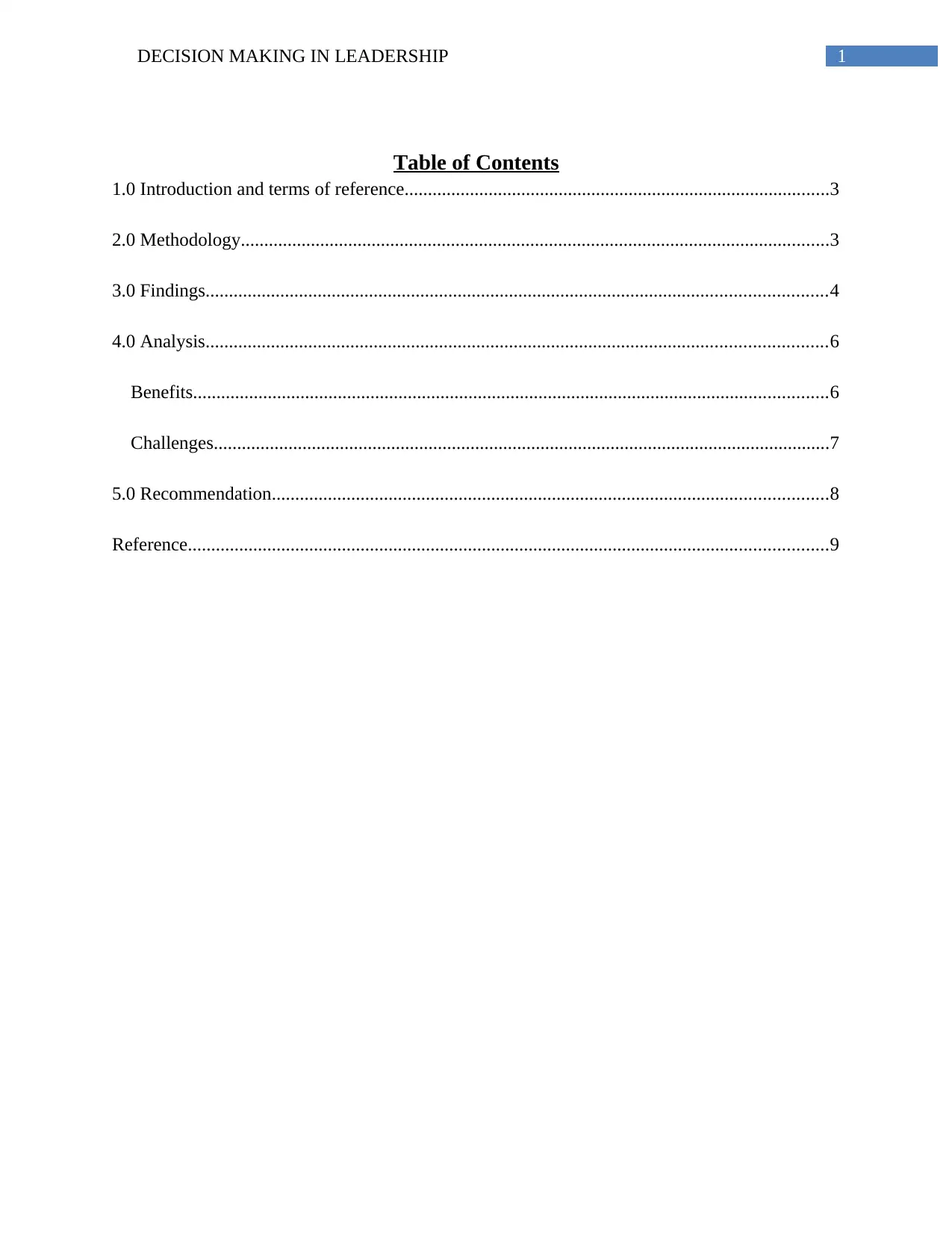
1DECISION MAKING IN LEADERSHIP
Table of Contents
1.0 Introduction and terms of reference...........................................................................................3
2.0 Methodology..............................................................................................................................3
3.0 Findings.....................................................................................................................................4
4.0 Analysis.....................................................................................................................................6
Benefits........................................................................................................................................6
Challenges....................................................................................................................................7
5.0 Recommendation.......................................................................................................................8
Reference.........................................................................................................................................9
Table of Contents
1.0 Introduction and terms of reference...........................................................................................3
2.0 Methodology..............................................................................................................................3
3.0 Findings.....................................................................................................................................4
4.0 Analysis.....................................................................................................................................6
Benefits........................................................................................................................................6
Challenges....................................................................................................................................7
5.0 Recommendation.......................................................................................................................8
Reference.........................................................................................................................................9
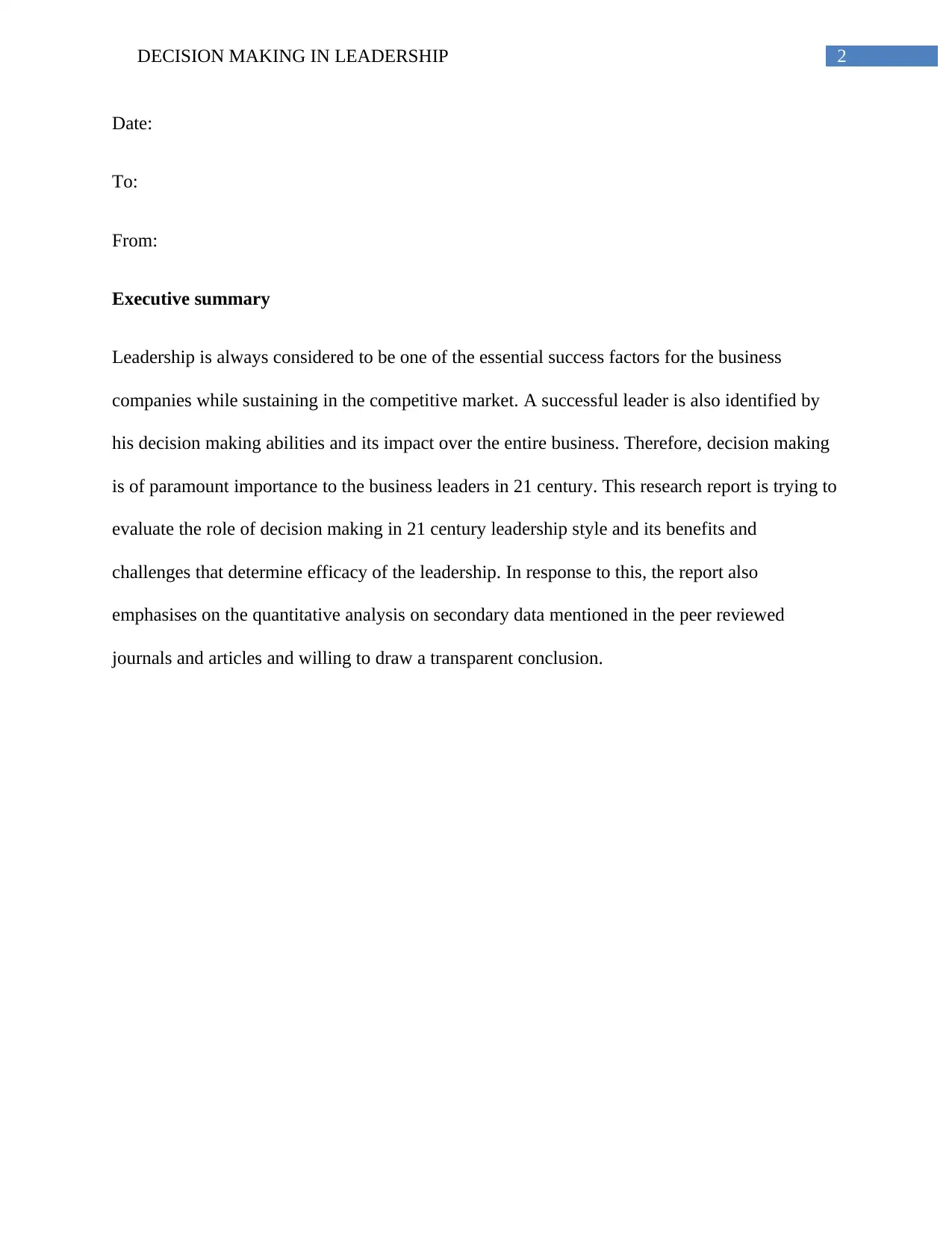
2DECISION MAKING IN LEADERSHIP
Date:
To:
From:
Executive summary
Leadership is always considered to be one of the essential success factors for the business
companies while sustaining in the competitive market. A successful leader is also identified by
his decision making abilities and its impact over the entire business. Therefore, decision making
is of paramount importance to the business leaders in 21 century. This research report is trying to
evaluate the role of decision making in 21 century leadership style and its benefits and
challenges that determine efficacy of the leadership. In response to this, the report also
emphasises on the quantitative analysis on secondary data mentioned in the peer reviewed
journals and articles and willing to draw a transparent conclusion.
Date:
To:
From:
Executive summary
Leadership is always considered to be one of the essential success factors for the business
companies while sustaining in the competitive market. A successful leader is also identified by
his decision making abilities and its impact over the entire business. Therefore, decision making
is of paramount importance to the business leaders in 21 century. This research report is trying to
evaluate the role of decision making in 21 century leadership style and its benefits and
challenges that determine efficacy of the leadership. In response to this, the report also
emphasises on the quantitative analysis on secondary data mentioned in the peer reviewed
journals and articles and willing to draw a transparent conclusion.
⊘ This is a preview!⊘
Do you want full access?
Subscribe today to unlock all pages.

Trusted by 1+ million students worldwide
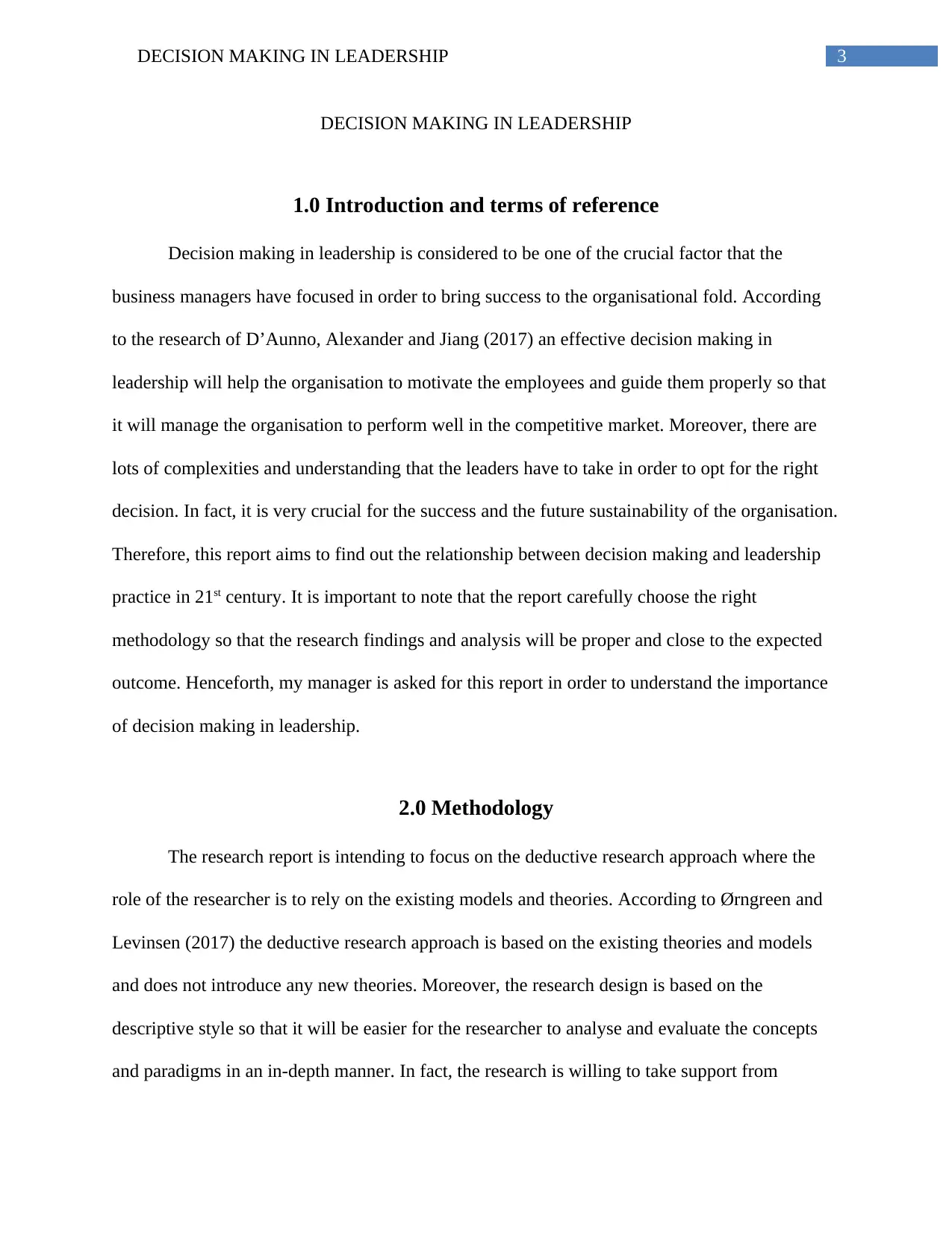
3DECISION MAKING IN LEADERSHIP
DECISION MAKING IN LEADERSHIP
1.0 Introduction and terms of reference
Decision making in leadership is considered to be one of the crucial factor that the
business managers have focused in order to bring success to the organisational fold. According
to the research of D’Aunno, Alexander and Jiang (2017) an effective decision making in
leadership will help the organisation to motivate the employees and guide them properly so that
it will manage the organisation to perform well in the competitive market. Moreover, there are
lots of complexities and understanding that the leaders have to take in order to opt for the right
decision. In fact, it is very crucial for the success and the future sustainability of the organisation.
Therefore, this report aims to find out the relationship between decision making and leadership
practice in 21st century. It is important to note that the report carefully choose the right
methodology so that the research findings and analysis will be proper and close to the expected
outcome. Henceforth, my manager is asked for this report in order to understand the importance
of decision making in leadership.
2.0 Methodology
The research report is intending to focus on the deductive research approach where the
role of the researcher is to rely on the existing models and theories. According to Ørngreen and
Levinsen (2017) the deductive research approach is based on the existing theories and models
and does not introduce any new theories. Moreover, the research design is based on the
descriptive style so that it will be easier for the researcher to analyse and evaluate the concepts
and paradigms in an in-depth manner. In fact, the research is willing to take support from
DECISION MAKING IN LEADERSHIP
1.0 Introduction and terms of reference
Decision making in leadership is considered to be one of the crucial factor that the
business managers have focused in order to bring success to the organisational fold. According
to the research of D’Aunno, Alexander and Jiang (2017) an effective decision making in
leadership will help the organisation to motivate the employees and guide them properly so that
it will manage the organisation to perform well in the competitive market. Moreover, there are
lots of complexities and understanding that the leaders have to take in order to opt for the right
decision. In fact, it is very crucial for the success and the future sustainability of the organisation.
Therefore, this report aims to find out the relationship between decision making and leadership
practice in 21st century. It is important to note that the report carefully choose the right
methodology so that the research findings and analysis will be proper and close to the expected
outcome. Henceforth, my manager is asked for this report in order to understand the importance
of decision making in leadership.
2.0 Methodology
The research report is intending to focus on the deductive research approach where the
role of the researcher is to rely on the existing models and theories. According to Ørngreen and
Levinsen (2017) the deductive research approach is based on the existing theories and models
and does not introduce any new theories. Moreover, the research design is based on the
descriptive style so that it will be easier for the researcher to analyse and evaluate the concepts
and paradigms in an in-depth manner. In fact, the research is willing to take support from
Paraphrase This Document
Need a fresh take? Get an instant paraphrase of this document with our AI Paraphraser

4DECISION MAKING IN LEADERSHIP
secondary data sources in terms of the empirical evidences and literature review. Therefore, it is
very essential for the research to choose the peer reviewed journals and analyse it properly.
Henceforth, a quantitative approach is also incorporated into the research so that it can will help
the researcher to extract the expected outcome from the research. It is important to note that the
research will entirely focused on the secondary quantitative analysis which is backed by the
literature review. The purpose of choosing the peer reviewed journals is to find out justified
outcome from the articles and journals.
3.0 Findings
According to the research of Griffith, Zeni and Johnson (2016) for an effective decision
making of a leader it is very important for the person to identify the critical factors at first. The
motive behind identifying the most important critical factors is to identify the root cause of the
problem and figures out the reasons behind the problem. From the research of Lean Keng and
AlQudah (2017) it can be stated that problem identification is the backbone of entire decision
making process of a leader because the decisions are made on the nature of the problem.
Therefore, it is always considered to be one of the most important aspects for the leaders to
identify and understand the problems extensively.
The next step is to highlight the potential options of mitigating the problem. McHugh et
al. (2016) opined that it is very crucial for a successful leader to not only identify the problem
but also provide feasible solutions that can bring efficacy to the organisation. Sustainability is the
most crucial part for the organisation and it is the responsibility of the leader to ensure the aims
and objectives of the organisation. Henceforth, the alternative options provides enough options
secondary data sources in terms of the empirical evidences and literature review. Therefore, it is
very essential for the research to choose the peer reviewed journals and analyse it properly.
Henceforth, a quantitative approach is also incorporated into the research so that it can will help
the researcher to extract the expected outcome from the research. It is important to note that the
research will entirely focused on the secondary quantitative analysis which is backed by the
literature review. The purpose of choosing the peer reviewed journals is to find out justified
outcome from the articles and journals.
3.0 Findings
According to the research of Griffith, Zeni and Johnson (2016) for an effective decision
making of a leader it is very important for the person to identify the critical factors at first. The
motive behind identifying the most important critical factors is to identify the root cause of the
problem and figures out the reasons behind the problem. From the research of Lean Keng and
AlQudah (2017) it can be stated that problem identification is the backbone of entire decision
making process of a leader because the decisions are made on the nature of the problem.
Therefore, it is always considered to be one of the most important aspects for the leaders to
identify and understand the problems extensively.
The next step is to highlight the potential options of mitigating the problem. McHugh et
al. (2016) opined that it is very crucial for a successful leader to not only identify the problem
but also provide feasible solutions that can bring efficacy to the organisation. Sustainability is the
most crucial part for the organisation and it is the responsibility of the leader to ensure the aims
and objectives of the organisation. Henceforth, the alternative options provides enough options
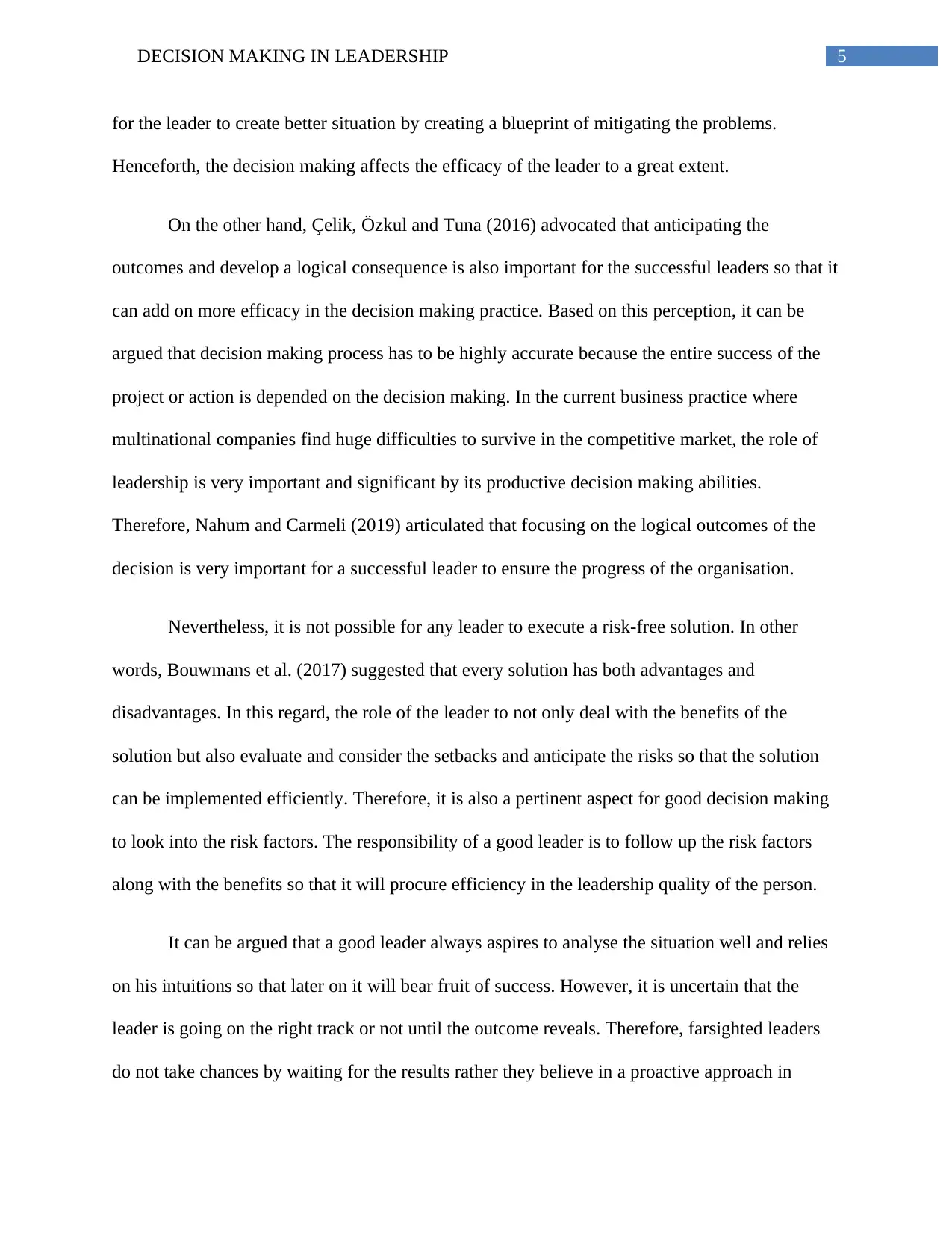
5DECISION MAKING IN LEADERSHIP
for the leader to create better situation by creating a blueprint of mitigating the problems.
Henceforth, the decision making affects the efficacy of the leader to a great extent.
On the other hand, Çelik, Özkul and Tuna (2016) advocated that anticipating the
outcomes and develop a logical consequence is also important for the successful leaders so that it
can add on more efficacy in the decision making practice. Based on this perception, it can be
argued that decision making process has to be highly accurate because the entire success of the
project or action is depended on the decision making. In the current business practice where
multinational companies find huge difficulties to survive in the competitive market, the role of
leadership is very important and significant by its productive decision making abilities.
Therefore, Nahum and Carmeli (2019) articulated that focusing on the logical outcomes of the
decision is very important for a successful leader to ensure the progress of the organisation.
Nevertheless, it is not possible for any leader to execute a risk-free solution. In other
words, Bouwmans et al. (2017) suggested that every solution has both advantages and
disadvantages. In this regard, the role of the leader to not only deal with the benefits of the
solution but also evaluate and consider the setbacks and anticipate the risks so that the solution
can be implemented efficiently. Therefore, it is also a pertinent aspect for good decision making
to look into the risk factors. The responsibility of a good leader is to follow up the risk factors
along with the benefits so that it will procure efficiency in the leadership quality of the person.
It can be argued that a good leader always aspires to analyse the situation well and relies
on his intuitions so that later on it will bear fruit of success. However, it is uncertain that the
leader is going on the right track or not until the outcome reveals. Therefore, farsighted leaders
do not take chances by waiting for the results rather they believe in a proactive approach in
for the leader to create better situation by creating a blueprint of mitigating the problems.
Henceforth, the decision making affects the efficacy of the leader to a great extent.
On the other hand, Çelik, Özkul and Tuna (2016) advocated that anticipating the
outcomes and develop a logical consequence is also important for the successful leaders so that it
can add on more efficacy in the decision making practice. Based on this perception, it can be
argued that decision making process has to be highly accurate because the entire success of the
project or action is depended on the decision making. In the current business practice where
multinational companies find huge difficulties to survive in the competitive market, the role of
leadership is very important and significant by its productive decision making abilities.
Therefore, Nahum and Carmeli (2019) articulated that focusing on the logical outcomes of the
decision is very important for a successful leader to ensure the progress of the organisation.
Nevertheless, it is not possible for any leader to execute a risk-free solution. In other
words, Bouwmans et al. (2017) suggested that every solution has both advantages and
disadvantages. In this regard, the role of the leader to not only deal with the benefits of the
solution but also evaluate and consider the setbacks and anticipate the risks so that the solution
can be implemented efficiently. Therefore, it is also a pertinent aspect for good decision making
to look into the risk factors. The responsibility of a good leader is to follow up the risk factors
along with the benefits so that it will procure efficiency in the leadership quality of the person.
It can be argued that a good leader always aspires to analyse the situation well and relies
on his intuitions so that later on it will bear fruit of success. However, it is uncertain that the
leader is going on the right track or not until the outcome reveals. Therefore, farsighted leaders
do not take chances by waiting for the results rather they believe in a proactive approach in
⊘ This is a preview!⊘
Do you want full access?
Subscribe today to unlock all pages.

Trusted by 1+ million students worldwide
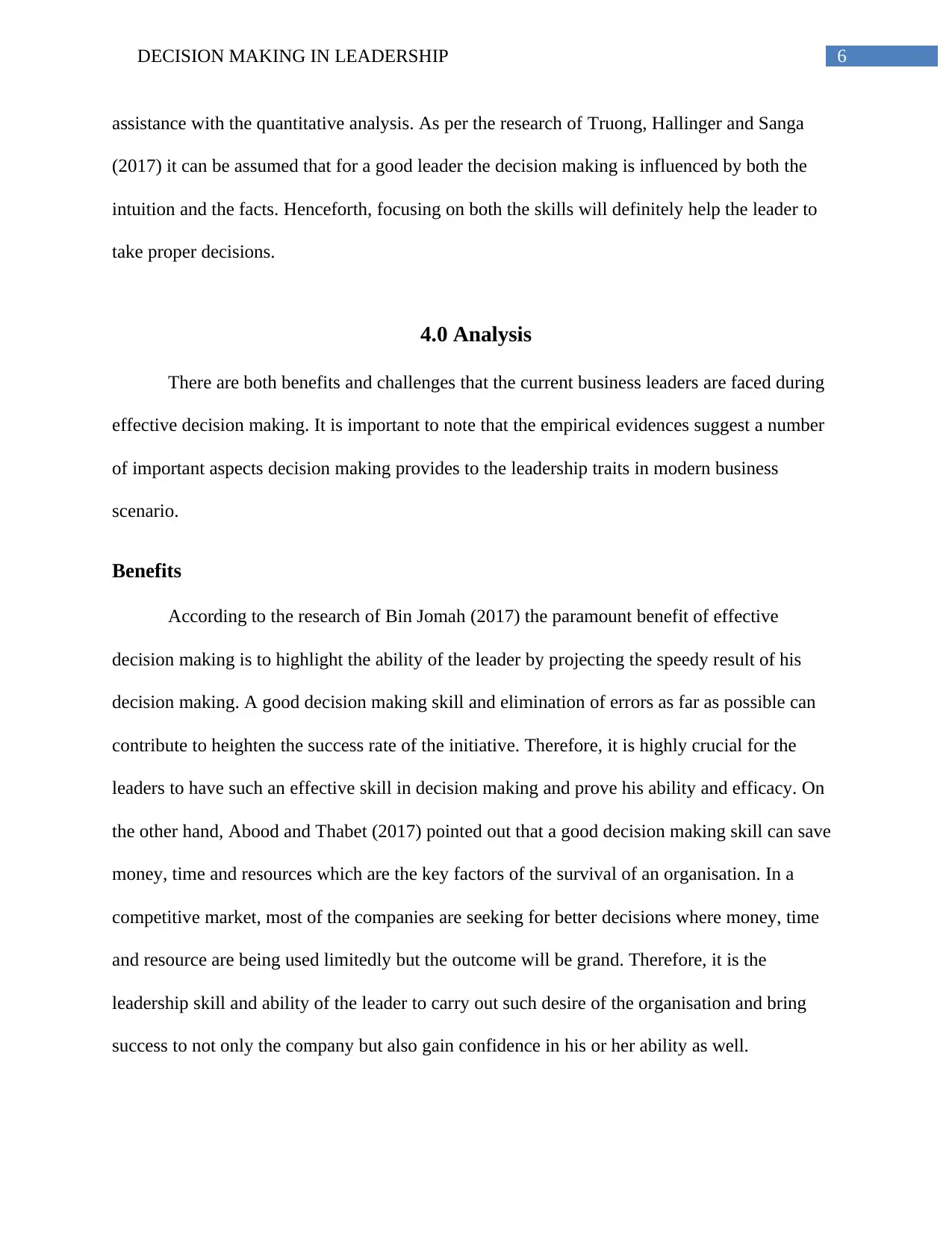
6DECISION MAKING IN LEADERSHIP
assistance with the quantitative analysis. As per the research of Truong, Hallinger and Sanga
(2017) it can be assumed that for a good leader the decision making is influenced by both the
intuition and the facts. Henceforth, focusing on both the skills will definitely help the leader to
take proper decisions.
4.0 Analysis
There are both benefits and challenges that the current business leaders are faced during
effective decision making. It is important to note that the empirical evidences suggest a number
of important aspects decision making provides to the leadership traits in modern business
scenario.
Benefits
According to the research of Bin Jomah (2017) the paramount benefit of effective
decision making is to highlight the ability of the leader by projecting the speedy result of his
decision making. A good decision making skill and elimination of errors as far as possible can
contribute to heighten the success rate of the initiative. Therefore, it is highly crucial for the
leaders to have such an effective skill in decision making and prove his ability and efficacy. On
the other hand, Abood and Thabet (2017) pointed out that a good decision making skill can save
money, time and resources which are the key factors of the survival of an organisation. In a
competitive market, most of the companies are seeking for better decisions where money, time
and resource are being used limitedly but the outcome will be grand. Therefore, it is the
leadership skill and ability of the leader to carry out such desire of the organisation and bring
success to not only the company but also gain confidence in his or her ability as well.
assistance with the quantitative analysis. As per the research of Truong, Hallinger and Sanga
(2017) it can be assumed that for a good leader the decision making is influenced by both the
intuition and the facts. Henceforth, focusing on both the skills will definitely help the leader to
take proper decisions.
4.0 Analysis
There are both benefits and challenges that the current business leaders are faced during
effective decision making. It is important to note that the empirical evidences suggest a number
of important aspects decision making provides to the leadership traits in modern business
scenario.
Benefits
According to the research of Bin Jomah (2017) the paramount benefit of effective
decision making is to highlight the ability of the leader by projecting the speedy result of his
decision making. A good decision making skill and elimination of errors as far as possible can
contribute to heighten the success rate of the initiative. Therefore, it is highly crucial for the
leaders to have such an effective skill in decision making and prove his ability and efficacy. On
the other hand, Abood and Thabet (2017) pointed out that a good decision making skill can save
money, time and resources which are the key factors of the survival of an organisation. In a
competitive market, most of the companies are seeking for better decisions where money, time
and resource are being used limitedly but the outcome will be grand. Therefore, it is the
leadership skill and ability of the leader to carry out such desire of the organisation and bring
success to not only the company but also gain confidence in his or her ability as well.
Paraphrase This Document
Need a fresh take? Get an instant paraphrase of this document with our AI Paraphraser

7DECISION MAKING IN LEADERSHIP
As opined by Aritz et al. (2017) a good decision making can always provide huge sense
of individual achievement and fulfilment for the leader. It is always important for a successful
leader to gain the motivation and confidence of taking major decisions. The expertise and
experiences play significant role in this aspect but the success of the decision can only bring
utmost happiness and satisfaction to the leader. Therefore, it can be stated that the success of a
leader is always depended on fruitful decision making and converts the success into long term
achievement for the leader. In association with this, the professional approach of the leader is
also under the scrutiny and can be analysed by his way of decision making and the rate of
success in decisions. Roy (2018) highlighted that the rate of success in decision making prove
the nature of professionalism and merit of the leader. As a result of that there is huge benefit for
the modern business leaders to make proper decisions not only for the success of the organisation
but for his or her own development as well.
Challenges
Despite of having a series of benefits decision making can create lots of challenges in
leadership as well. For instance, Watts et al. (2018) articulated that indecisions can create lack of
confidence among the leaders which is not a good sign for the long term benefits of the
organisation. It can be argued that managerial indecisions reflect failure of the leader to propose
right solutions for the benefit of the organisation. As a result of that it will be a serious challenge
for the leader to prove his ability in one hand and bring future sustainability to the organisation
on the other. Therefore, it is a grave problem for the leaders to take the right decision and ensure
success of the organisation. Moreover, Clifton (2017) opined that during the decision making
process a leader has come up with a number of ideas or suggestions and gradually choose the
appropriate one. Due to have too many options often leaders are puzzled to identify which of the
As opined by Aritz et al. (2017) a good decision making can always provide huge sense
of individual achievement and fulfilment for the leader. It is always important for a successful
leader to gain the motivation and confidence of taking major decisions. The expertise and
experiences play significant role in this aspect but the success of the decision can only bring
utmost happiness and satisfaction to the leader. Therefore, it can be stated that the success of a
leader is always depended on fruitful decision making and converts the success into long term
achievement for the leader. In association with this, the professional approach of the leader is
also under the scrutiny and can be analysed by his way of decision making and the rate of
success in decisions. Roy (2018) highlighted that the rate of success in decision making prove
the nature of professionalism and merit of the leader. As a result of that there is huge benefit for
the modern business leaders to make proper decisions not only for the success of the organisation
but for his or her own development as well.
Challenges
Despite of having a series of benefits decision making can create lots of challenges in
leadership as well. For instance, Watts et al. (2018) articulated that indecisions can create lack of
confidence among the leaders which is not a good sign for the long term benefits of the
organisation. It can be argued that managerial indecisions reflect failure of the leader to propose
right solutions for the benefit of the organisation. As a result of that it will be a serious challenge
for the leader to prove his ability in one hand and bring future sustainability to the organisation
on the other. Therefore, it is a grave problem for the leaders to take the right decision and ensure
success of the organisation. Moreover, Clifton (2017) opined that during the decision making
process a leader has come up with a number of ideas or suggestions and gradually choose the
appropriate one. Due to have too many options often leaders are puzzled to identify which of the
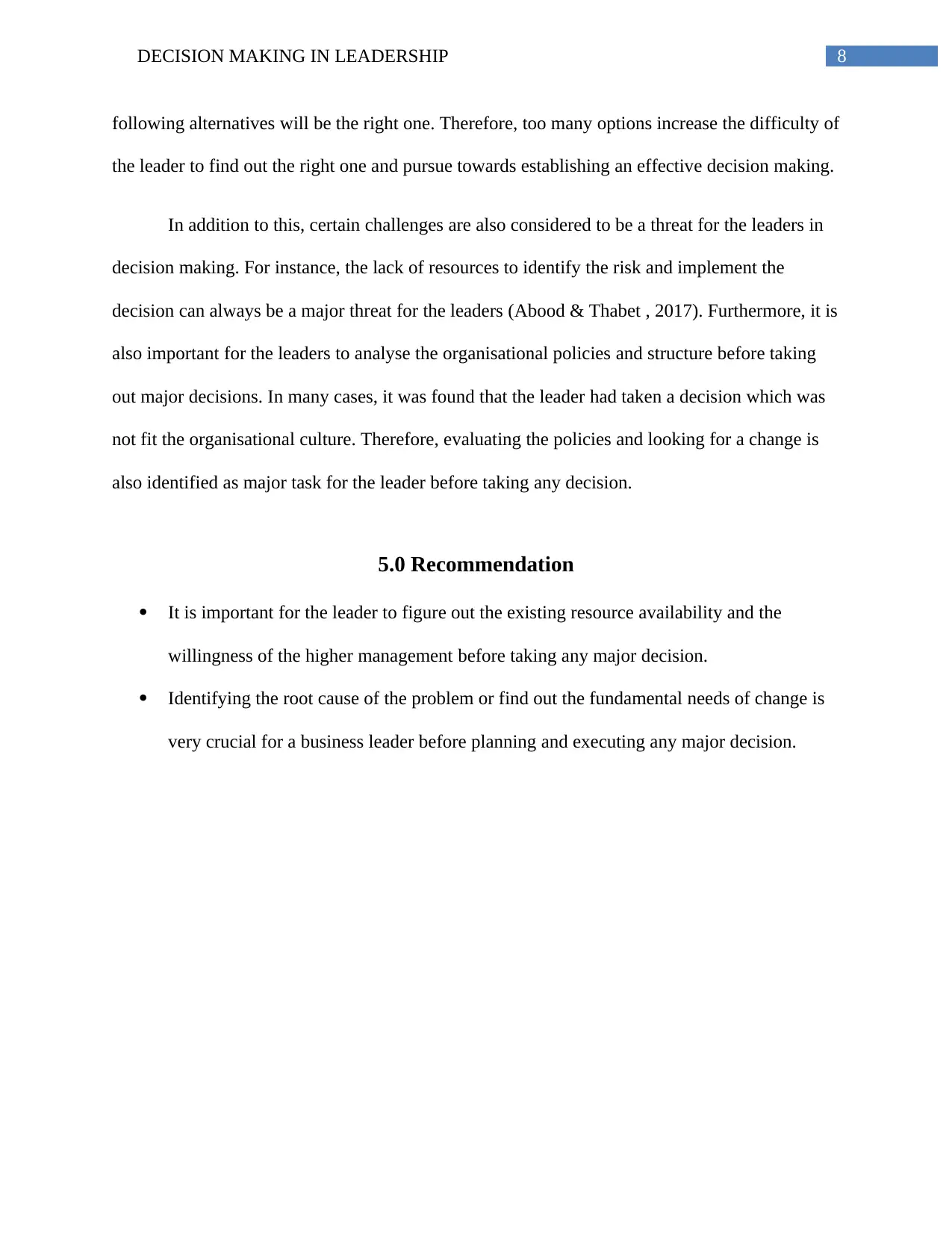
8DECISION MAKING IN LEADERSHIP
following alternatives will be the right one. Therefore, too many options increase the difficulty of
the leader to find out the right one and pursue towards establishing an effective decision making.
In addition to this, certain challenges are also considered to be a threat for the leaders in
decision making. For instance, the lack of resources to identify the risk and implement the
decision can always be a major threat for the leaders (Abood & Thabet , 2017). Furthermore, it is
also important for the leaders to analyse the organisational policies and structure before taking
out major decisions. In many cases, it was found that the leader had taken a decision which was
not fit the organisational culture. Therefore, evaluating the policies and looking for a change is
also identified as major task for the leader before taking any decision.
5.0 Recommendation
It is important for the leader to figure out the existing resource availability and the
willingness of the higher management before taking any major decision.
Identifying the root cause of the problem or find out the fundamental needs of change is
very crucial for a business leader before planning and executing any major decision.
following alternatives will be the right one. Therefore, too many options increase the difficulty of
the leader to find out the right one and pursue towards establishing an effective decision making.
In addition to this, certain challenges are also considered to be a threat for the leaders in
decision making. For instance, the lack of resources to identify the risk and implement the
decision can always be a major threat for the leaders (Abood & Thabet , 2017). Furthermore, it is
also important for the leaders to analyse the organisational policies and structure before taking
out major decisions. In many cases, it was found that the leader had taken a decision which was
not fit the organisational culture. Therefore, evaluating the policies and looking for a change is
also identified as major task for the leader before taking any decision.
5.0 Recommendation
It is important for the leader to figure out the existing resource availability and the
willingness of the higher management before taking any major decision.
Identifying the root cause of the problem or find out the fundamental needs of change is
very crucial for a business leader before planning and executing any major decision.
⊘ This is a preview!⊘
Do you want full access?
Subscribe today to unlock all pages.

Trusted by 1+ million students worldwide

9DECISION MAKING IN LEADERSHIP
Reference
Abood, S., & Thabet, M. (2017). Impact of Leadership Styles on Decision Making Styles among
Nurses' Managerial Levels. Journal of Nursing and Health Science, 6(5), 71-78.
Aritz, J., Walker, R., Cardon, P., & Li, Z. (2017). Discourse of leadership: The power of
questions in organizational decision making. International Journal of Business
Communication, 54(2), 161-181.
Bin Jomah, N. (2017). Perceptions of Employees in the Effects of Decision-Making and
Leadership Styles on Relationships and Perceived Effectiveness in King Saud University
Development Context. International Education Studies, 10(1), 197-210.
Bouwmans, M., Runhaar, P., Wesselink, R., & Mulder, M. (2017). Fostering teachers' team
learning: An interplay between transformational leadership and participative decision-
making?. Teaching and Teacher Education, 65, 71-80.
Çelik, S., Özkul, E., & Tuna, P. F. (2016). The relationship between strategic decision-making
and leadership styles: an application in 4 and 5-star hotels in Istanbul. İşletme
Araştırmaları Dergisi, 8(1), 240-264.
Clifton, J. (2017). Taking the (heroic) leader out of leadership. The in situ practice of distributed
leadership in decision-making talk. In Challenging leadership stereotypes through
discourse (pp. 45-68). Springer, Singapore.
Reference
Abood, S., & Thabet, M. (2017). Impact of Leadership Styles on Decision Making Styles among
Nurses' Managerial Levels. Journal of Nursing and Health Science, 6(5), 71-78.
Aritz, J., Walker, R., Cardon, P., & Li, Z. (2017). Discourse of leadership: The power of
questions in organizational decision making. International Journal of Business
Communication, 54(2), 161-181.
Bin Jomah, N. (2017). Perceptions of Employees in the Effects of Decision-Making and
Leadership Styles on Relationships and Perceived Effectiveness in King Saud University
Development Context. International Education Studies, 10(1), 197-210.
Bouwmans, M., Runhaar, P., Wesselink, R., & Mulder, M. (2017). Fostering teachers' team
learning: An interplay between transformational leadership and participative decision-
making?. Teaching and Teacher Education, 65, 71-80.
Çelik, S., Özkul, E., & Tuna, P. F. (2016). The relationship between strategic decision-making
and leadership styles: an application in 4 and 5-star hotels in Istanbul. İşletme
Araştırmaları Dergisi, 8(1), 240-264.
Clifton, J. (2017). Taking the (heroic) leader out of leadership. The in situ practice of distributed
leadership in decision-making talk. In Challenging leadership stereotypes through
discourse (pp. 45-68). Springer, Singapore.
Paraphrase This Document
Need a fresh take? Get an instant paraphrase of this document with our AI Paraphraser
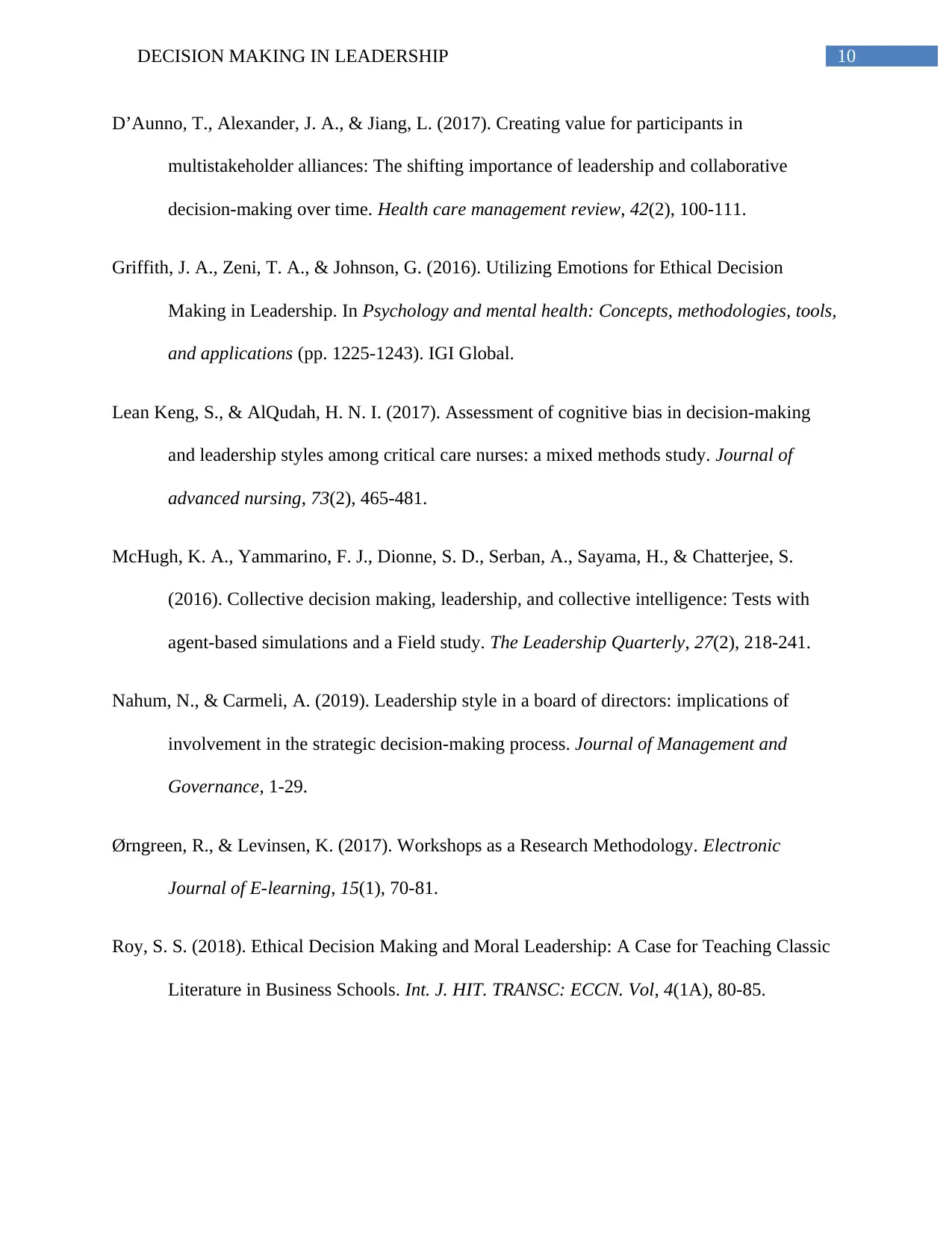
10DECISION MAKING IN LEADERSHIP
D’Aunno, T., Alexander, J. A., & Jiang, L. (2017). Creating value for participants in
multistakeholder alliances: The shifting importance of leadership and collaborative
decision-making over time. Health care management review, 42(2), 100-111.
Griffith, J. A., Zeni, T. A., & Johnson, G. (2016). Utilizing Emotions for Ethical Decision
Making in Leadership. In Psychology and mental health: Concepts, methodologies, tools,
and applications (pp. 1225-1243). IGI Global.
Lean Keng, S., & AlQudah, H. N. I. (2017). Assessment of cognitive bias in decision‐making
and leadership styles among critical care nurses: a mixed methods study. Journal of
advanced nursing, 73(2), 465-481.
McHugh, K. A., Yammarino, F. J., Dionne, S. D., Serban, A., Sayama, H., & Chatterjee, S.
(2016). Collective decision making, leadership, and collective intelligence: Tests with
agent-based simulations and a Field study. The Leadership Quarterly, 27(2), 218-241.
Nahum, N., & Carmeli, A. (2019). Leadership style in a board of directors: implications of
involvement in the strategic decision-making process. Journal of Management and
Governance, 1-29.
Ørngreen, R., & Levinsen, K. (2017). Workshops as a Research Methodology. Electronic
Journal of E-learning, 15(1), 70-81.
Roy, S. S. (2018). Ethical Decision Making and Moral Leadership: A Case for Teaching Classic
Literature in Business Schools. Int. J. HIT. TRANSC: ECCN. Vol, 4(1A), 80-85.
D’Aunno, T., Alexander, J. A., & Jiang, L. (2017). Creating value for participants in
multistakeholder alliances: The shifting importance of leadership and collaborative
decision-making over time. Health care management review, 42(2), 100-111.
Griffith, J. A., Zeni, T. A., & Johnson, G. (2016). Utilizing Emotions for Ethical Decision
Making in Leadership. In Psychology and mental health: Concepts, methodologies, tools,
and applications (pp. 1225-1243). IGI Global.
Lean Keng, S., & AlQudah, H. N. I. (2017). Assessment of cognitive bias in decision‐making
and leadership styles among critical care nurses: a mixed methods study. Journal of
advanced nursing, 73(2), 465-481.
McHugh, K. A., Yammarino, F. J., Dionne, S. D., Serban, A., Sayama, H., & Chatterjee, S.
(2016). Collective decision making, leadership, and collective intelligence: Tests with
agent-based simulations and a Field study. The Leadership Quarterly, 27(2), 218-241.
Nahum, N., & Carmeli, A. (2019). Leadership style in a board of directors: implications of
involvement in the strategic decision-making process. Journal of Management and
Governance, 1-29.
Ørngreen, R., & Levinsen, K. (2017). Workshops as a Research Methodology. Electronic
Journal of E-learning, 15(1), 70-81.
Roy, S. S. (2018). Ethical Decision Making and Moral Leadership: A Case for Teaching Classic
Literature in Business Schools. Int. J. HIT. TRANSC: ECCN. Vol, 4(1A), 80-85.

11DECISION MAKING IN LEADERSHIP
Truong, T. D., Hallinger, P., & Sanga, K. (2017). Confucian values and school leadership in
Vietnam: Exploring the influence of culture on principal decision making. Educational
Management Administration & Leadership, 45(1), 77-100.
Watts, L. L., Ness, A. M., Steele, L. M., & Mumford, M. D. (2018). Learning from stories of
leadership: How reading about personalized and socialized politicians impacts
performance on an ethical decision-making simulation. The Leadership Quarterly, 29(2),
276-294.
Truong, T. D., Hallinger, P., & Sanga, K. (2017). Confucian values and school leadership in
Vietnam: Exploring the influence of culture on principal decision making. Educational
Management Administration & Leadership, 45(1), 77-100.
Watts, L. L., Ness, A. M., Steele, L. M., & Mumford, M. D. (2018). Learning from stories of
leadership: How reading about personalized and socialized politicians impacts
performance on an ethical decision-making simulation. The Leadership Quarterly, 29(2),
276-294.
⊘ This is a preview!⊘
Do you want full access?
Subscribe today to unlock all pages.

Trusted by 1+ million students worldwide
1 out of 12
Related Documents
Your All-in-One AI-Powered Toolkit for Academic Success.
+13062052269
info@desklib.com
Available 24*7 on WhatsApp / Email
![[object Object]](/_next/static/media/star-bottom.7253800d.svg)
Unlock your academic potential
Copyright © 2020–2025 A2Z Services. All Rights Reserved. Developed and managed by ZUCOL.





